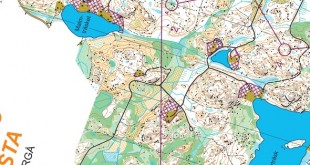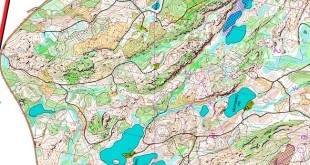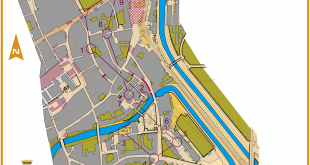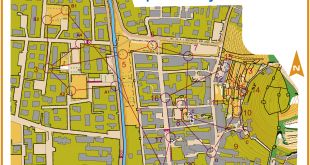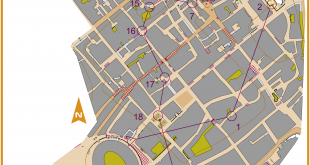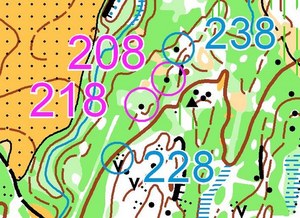 Macr-o orienteering is a further development of the micr-o concept, a concept originally developed mainly to market orienteering as a better TV sport. Macr-o is however something very different from micr-o. The motivation here is not mainly to promote orienteering as a TV sport, but rather macr-o is brought forward as a gaffling principle, to split up groups of runners running together, and to increase the amount of fine orienteering required. This is motivated partly by the fact that medals have been decided due to groups of runners running together in recent world championships.
Macr-o orienteering is a further development of the micr-o concept, a concept originally developed mainly to market orienteering as a better TV sport. Macr-o is however something very different from micr-o. The motivation here is not mainly to promote orienteering as a TV sport, but rather macr-o is brought forward as a gaffling principle, to split up groups of runners running together, and to increase the amount of fine orienteering required. This is motivated partly by the fact that medals have been decided due to groups of runners running together in recent world championships.
The first test of macr-o in an orienteering competition was at the long distance at “Norwegian Spring” at the 15th of April this year. There have been quite heated discussions about this, as “Norwegian Spring” was both a WRE race and a test race for the Open Nordic Championships for the Norwegian Team. The biggest controversy in this regard has been the fact that Macr-o is actually a form of gaffling, and that runners run different courses. However, the organizers had gotten permission directly from the board of the Norwegian Orienteering Federation, and also gotten an “exception from rules” from the IOF for use of Macr-o in this single WRE competition as a test case.
In the 10 minute video below, the macr-o concept is briefly explained, and you see interviews with several of the world class elite runners at Norwegian Spring who tried out the novel concept for the first time.
(If loading is slow, please go directly to the video page)
Macr-o versus Micr-o
The Norwegian Orienteering Federation defines macr-o controls as micr-o controls used in a normal orienteering course on the normal map scale. Macr-o can be used in all disciplines, not only on the long distance. The runner can identify macr-o controls from the control description, as the code for macr-o controls are given as letters A, B, C and so on. In the forest, all macr-o controls in a macr-o cluster are marked with the corresponding letter instead of control code. The runners have to punch exactly one control in every macr-o cluster, if not they will be disqualified. Every wrong punch gives a penalty loop of about 30 seconds.
There are thus three main differences between macr-o and micr-o.
- There is no change of map scale in macr-o.
- Macr-o controls can be put anywhere in the course
- All runners will not run the same course
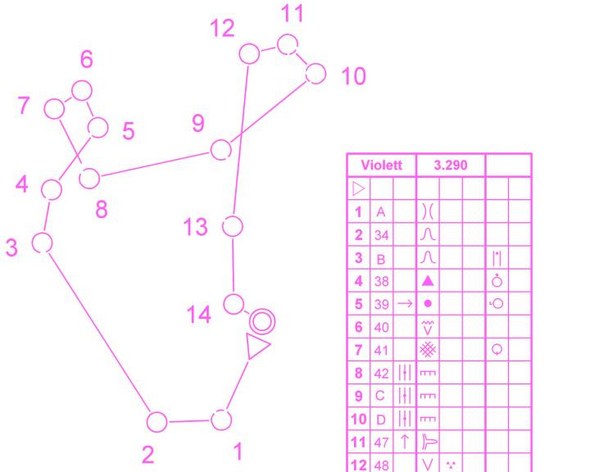
Unfairness?
This last point is the biggest controversy about macr-o. Many people find that a certain degree of unfairness is introduced by the fact that everybody does not run the same course. Even a few seconds in difference can be the difference between gold and 4th place in a World Championships. The inventors of macr-o handle the fairness issue by introducing the following rules for macr-o control placement:
- The maximum difference in the courses for different runners shall be 10 meters as measured in OCAD
- The difficulty shall be the same for the different controls
- The type of terrain shall be the same for running in and out of the controls.
In addition, they point at the fact that there is a lot of randomness present in orienteering already, as the map is not perfect representation of the terrain, and you can loose a second even by running at the wrong side of a tree.
Below you find a brief analysis of the Macr-o course used at the long distance at Norwegian Spring. As you see from the analysis, there might have been a certain unfairness for some of the Macr-o controls.
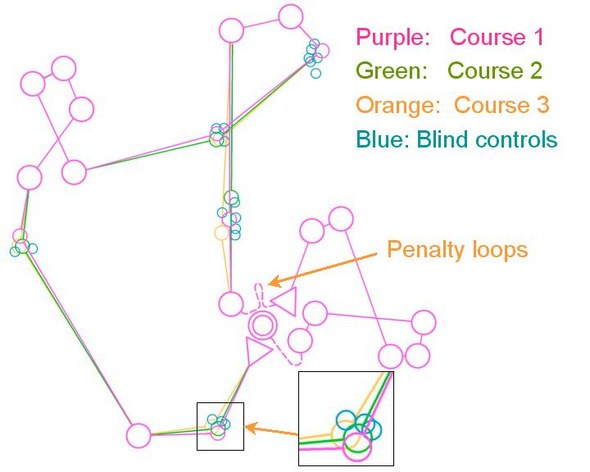
Macr-o as a spreading method
When we look at Macr-o as a spreading method, there are two ways Macr-o controls can spread runners
- Runners can be spread at the Macr-o controls, due to the fact that they have different controls, or due to the fact that they do not know if they have the same controls.
- Runners can be spread due to getting a different number of penalty loops.
A full analysis of the split times is required to see if Macr-o really works as a spreading method – but from the people I talked to it actually seems that Macr-o works better as a spreading method than the short butterflies commonly used for spreading today. See the video above for answers from some runners.
Great fun
And what do the runners think about macr-o? All I have spoken to at Norwegian Spring, including myself, think this is great fun, and most even think it is better than micr-o. But due to the fairness issue, most runners add “for training” when saying that this is great fun. Thus, the fairness issue is definitely a challenge for the ones working for macr-o. Personally, I think macr-o will have to be further developed in a fair way to survive.
Analysis of the Macr-o course at Norwegian Spring
The statistical material is actually too small to make a full analysis of the Macr-o course, but as all information is given below, one can treat the material accordingly. Note that the numbers are not double-checked.
Macr-o control A
At Macr-o control A, there were two alternatives – and two blind controls (typically running in from the north). 13 of 48 runners (27%) who had the control 213 got a penalty loop at this control, whereas 11 of 44 runners (25%) who had the control 223 got a penalty loop. The controls are very close to another, and one can easily see from one control to the other. Thus, this seems to be a “fair” Macr-o control from my point of view.
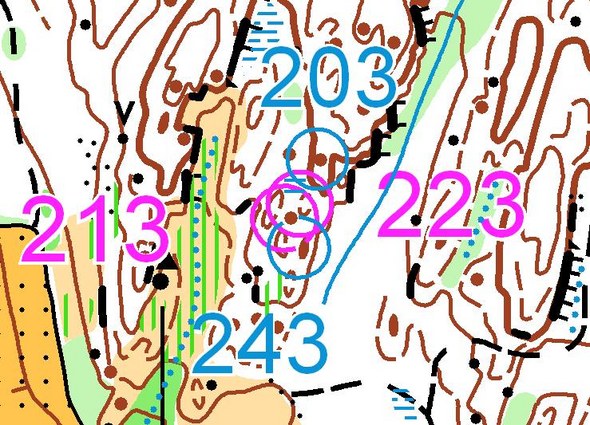
Macr-o control B
Again two alternatives at Macr-o control B (typically running in from the northeast). 10 of 69 runners (14%) who had control 204 got a penalty loop at this control, whereas 4 of 23 runners (17%) who had control 224 got a penalty loop at this control. Thus the controls seem to have approximately the same difficulty. However, as I see it, there may be different route choices to the two controls (coming in from the north or northwest), so there may be differences in split times? This is one of the controls were some runners have only seen their own control as said in the video above (I guess especially runners who had control 204).
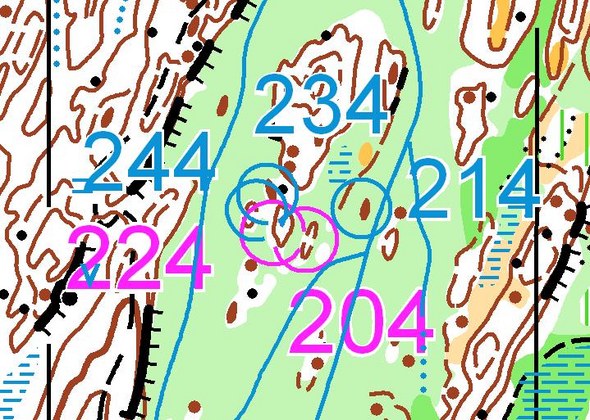
Macr-o control C
Here there are three alternatives, and no blind controls (typically running in from the path southwest of the control). Error rates are similar for all three controls: 1 of 24 (4%) for 225, 1 of 45 (2%) for 205 and 2 of 23 (8%) for 215. As for Macr-o control A, the controls are quite close, and you can see from control to control. Again I think this is a quite fair Macr-o control.
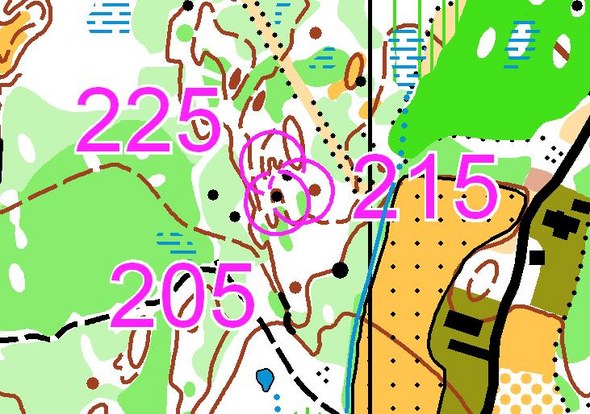
Macr-o control D
Here all runners have the same control (typically running in from the southwest), and there are two blind controls. 15 of 92 runners (16%) did an error here. As all runners have the same control here, one would think that Macr-o control D is definitely a fair Macr-o control. However, some may still argue that this is not completely fair, as runners choosing different route choices get different difficulty as some will see a blind control and some not. However, again I personally think this is a fair Macr-o control.
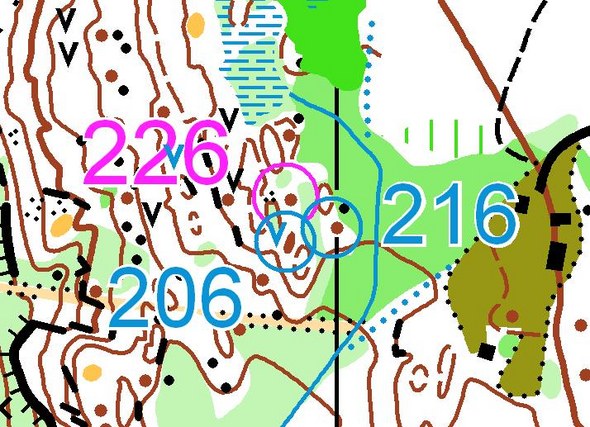
Macr-o control E
At Macr-o control E, there are three different controls – running in from the west. Here 12 of 45 (27%) did an error at control 217, 1 of 24 (4%) at control 207 and 0(!) of 23 (0%) did an error at control 227. Looking at the map, I think it is clear to see why more people did an error at control 217. There are two controls at the same detail (two sides of the depression), and you typically run through both the other controls before your control when going to control 227. From my point of view, this Macr-o control is not a fair control.
Actually, I got a penalty loop at this control as well. I punched the blind control at the other end of the depression, after running on compass from the path crossing. Another aspect here is that you get a significantly longer way to run for control 227 than for the other controls if you decide to use the path crossing as attack point as I did.
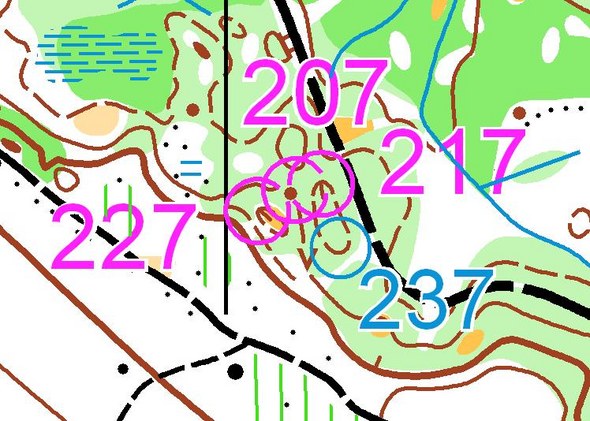
Macr-o control F
Macr-o control F had two alternatives and two blind controls – running in from the south. For 208, 7 of 24 runners (29%) did an error, whereas 7 of 68 runners (10%) did an error for control 218. Thus again, it seems like there is a difference in the errors for these two controls – and again there are most errors for the last control as seem from the direction people come into the control. Typically, people punch the first control they find if they are uncertain about where they are – rather than risking to search for minutes…
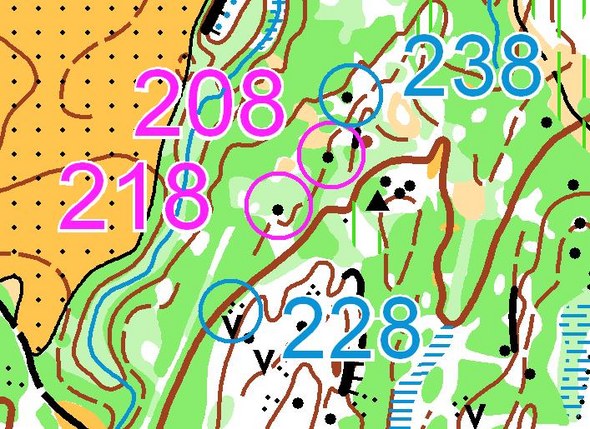
Penalty loop distribution
Below you see how many runners had how many penalty loops:
- 0 penalty loops: 37 runners
- 1 penalty loop: 36 runners
- 2 penalty loops: 20 runners
- 3 penalty loops: 2 runners
- 4 penalty loops: 1 runner
- 5 and 6 penalty loops: Nobody
Conclusion
The statistical material is too small to make a full analysis regarding fairness, and I have also only talked to around 20 of the total of 100 runners regarding Macr-o as a spreading principle. I will nevertheless try to make a small conclusion about the Macr-o experiment at Norwegian spring:
- Fairness: Based on my analysis of both penalty loops statistics and the map around the controls, it seems to me that 4 out of 6 Macr-o controls were quite fair. The two last controls were not completely fair as I see it, and I think it would have been quite embarrassing if a gold medal in a World Championship had been decided due to the gold medalist having the easier Macr-o control E and the silver medalist the most difficult Macr-o control E.
- Spreading: Interviews with runners (some of which you see in the video above), gave the information that about 50% of the runners did not see anybody else around the Macr-o controls at all, so there was no information to be gained from this. Of the ones who saw runners around the Macr-o controls or around the penalty loop region, actually quite a few found that the Macr-o controls worked as a spreading mechanism. But again, a few found that it worked opposite of the wanted effect. However, in total, Macr-o seems to be better at spreading runners than butterflies. Last time I did similar questions at a competition with butterflies, the answer from most runners were that the butterflies helped them to get together with other people rather than spreading them. Again, these are subjective answers from runners, but this gives an indication as to the mechanisms.
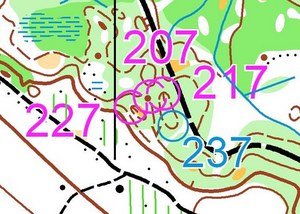 As an overall conclusion, I have to say that there are promising elements in Macr-o – the big downside being the fairness issue. I think Macr-o felt much more like the natural part of an orienteering race than Micr-o, and many of the runners I talked to felt the same way. A race with Macr-o is actually just like a normal orienteering race where you have to be a bit more concentrated at some controls. There is no awkward change of map scale, you don’t loose your flow, and it introduces certain interesting tactical aspects into orienteering.
As an overall conclusion, I have to say that there are promising elements in Macr-o – the big downside being the fairness issue. I think Macr-o felt much more like the natural part of an orienteering race than Micr-o, and many of the runners I talked to felt the same way. A race with Macr-o is actually just like a normal orienteering race where you have to be a bit more concentrated at some controls. There is no awkward change of map scale, you don’t loose your flow, and it introduces certain interesting tactical aspects into orienteering.
However, I don’t think Macr-o will survive in its present form as a gaffling method in individual races. All runners will have to run the same course, as I see it. If Macr-o is used, and everybody runs the same Macr-o course, there would still be some spreading left due to different runners having a different number of penalty loops. If Macr-o controls are put as early as possible in the course and in large butterflies with map exchange, and if the penalty loops are at about 2/3 of the complete course, Macr-o would give the maximum benefit for spreading runners as far as I see it.
Here is my suggestion for how you can combine Macr-o where every runner runs all the same splits and a long butterfly variant with map exchange (Update: This spreading method is called “Ultunametoden” – more info here [swedish]). Half of the runners will have the controls in the way given with purple numbers, the other half of the runners in the way given with blue numbers:

The half with blue numbers will have these two maps. Note that the runners will not know when they are inside a butterfly. By combining this with a fair type of Macr-o in addition, I think it would be possible to confuse the runners enough that you could not just run without thinking:
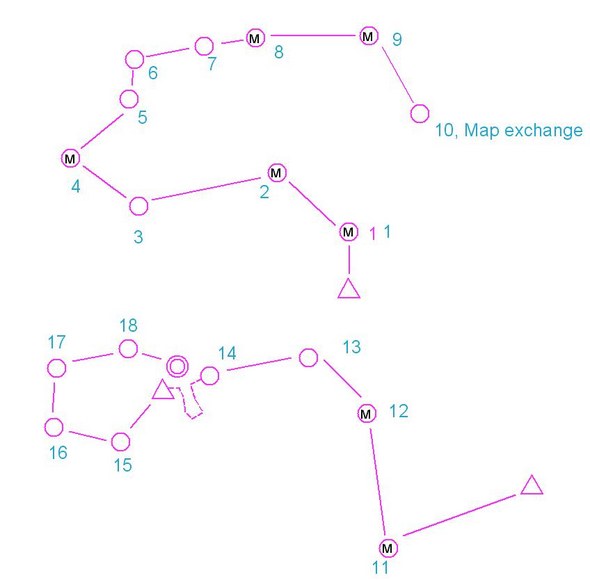
I am also unsure if Macr-o will give a lot as a gaffling principle for relays if this leads to gaffling controls being put closer together than today.
Note that all opinions given in this analysis are purely my personal opinions, and they are not in any way the opinions of the Norwegian Orienteering Federation or the people behind Macr-o. I would also like to thank the organizers of Norwegian Spring, who let me get access to part of the statistical material from Norwegian Spring to make this analysis.
Please add your comments in this matter below! I have also started a discussion thread over at Attackpoint where you can further discuss the matter.
Results, including number of penalty loops for each runner
| ||||||||||||||||||||||||||||||||||||||||||||||||||||||||||||||||||||||||||||||||||||||||||||||||||||||||||||||||||||||||||||||||||||||||||||||||||||||||||||||||||||||||||||||||||||||||||||||||||||||||||||||||||
| ||||||||||||||||||||||||||||||||||||||||||||||||||||||||||||||||||||||||||||||||||||||||||||||||||||||||||||||||||||||||||||||||||||||||||||||||||||||||||||||||||||||||||||||||||||||||||||||||||||||||||||||||||
| ||||||||||||||||||||||||||||||||||||||||||||||||||||||||||||||||||||||||||||||||||||||||||||||||||||||||||||||||||||||||||||||||||||||||||||||||||||||||||||||||||||||||||||||||||||||||||||||||||||||||||||||||||
| ||||||||||||||||||||||||||||||||||||||||||||||||||||||||||||||||||||||||||||||||||||||||||||||||||||||||||||||||||||||||||||||||||||||||||||||||||||||||||||||||||||||||||||||||||||||||||||||||||||||||||||||||||
| ||||||||||||||||||||||||||||||||||||||||||||||||||||||||||||||||||||||||||||||||||||||||||||||||||||||||||||||||||||||||||||||||||||||||||||||||||||||||||||||||||||||||||||||||||||||||||||||||||||||||||||||||||
| ||||||||||||||||||||||||||||||||||||||||||||||||||||||||||||||||||||||||||||||||||||||||||||||||||||||||||||||||||||||||||||||||||||||||||||||||||||||||||||||||||||||||||||||||||||||||||||||||||||||||||||||||||
 World of O News
World of O News
